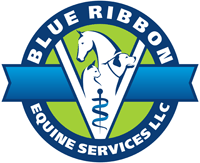|

Blue Ribbon Equine Services, LLC
Kelsey S. Strickland, DVM
Equine Parasite Control Recommendation
The American Association of Equine Practioners (AAEP) has a detailed, up-to-date recommendation on equine internal parasite control. These guidelines required modification due to the vast changes in anthelmentics (dewormers) since they were introduced over 40 years ago. We are seeing more horse owners becoming aware of the prevalence of anthelmintic resistance, however, there are still numerous equine owners that are continuing to rotationally deworm their stock which only worsens the resistance problem. The following is a brief synopsis of the AAEP recommendation.
Why Did We Need To Change How/When We Deworm?
- Intestinal parasites that cause the greatest threat to horses have changed over time. In adult horses we see more problems with small strongyles (cyathastomes). Foals and weanlings generally have more problems with roundworms (Parascaris Equorum).
- Horses less than three years of age are more susceptible to intestinal parasites and secondary compromise from them than horses over three years. For this reason, it is best to keep younger horses in separate pastures.
- Rotational deworming every 6-8 weeks creates a resistance to anthelmentics. EACH farm should be tested for anthelmintic parasite resistance.
- Every farm—every pasture can be different.
- Each horse can vary drastically in their parasite shedding pattern. Typically you can identify your “high parasite shedders” in your herd and selectively deworm them to keep your parasite levels under control. Using this method, you will save money on unnecessary wormers and lessen the future parasite resistance problem in your herd.
What are the goals of the Parasite Control Program on My Farm?
100% Parasite removal will not happen and should NEVER be a desirable goal!!!
Ideal goals
- Minimize risk
- Healthy adult horses will not show clinical signs of low levels of strongyles. High shedders and young horses should be targeted for treatment 3-4 times a year. All healthy horses and low shedders should NOT be treated.
- Reduce parasite egg shedding
- This is where it is important to know which horses in your herd are your “high shedders”. We can easily identify these horses by the submission of routine fecal samples. We could identify which horses in your herd are low shedders and should not be dewormed as well as the ones that should be your primary focus of your parasite control program.
- How to avoid further resistance
- ONLY deworm the animals that NEED to be treated at the appropriate time and with the appropriate drug!!!!!
|